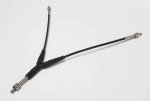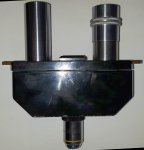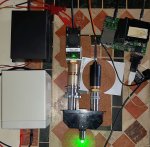Cloderic,
many thanks for the boos you are giving to this thread.
Please, can you tell me more about how you coupled the optical fiber SMA to the eyepiece?
Is there some distances you have to respect to optimase the signal collection?
Can you do a sketch to explan how you adjust the distances and different parts to conenct the optical fiber to the eyepiece.
Thank you again
C
Hello Civitus,
I understand your critical question about the optical composition which implies the very important compliance of different focal lengths and so on.
In this case, I solved the problem fairly easily and reliably with a few compromises.
I try to describe the beam path only theoretically:
From the laser, a parallel beam path (with divergence neglected by me) passes unchanged through several prism through the objektiv-lens.
There is the object to be examined in the focal point.
The raman signals now goes from this focal point through the same lens and generate behind this in turn a parallel beam.
Once again, several prisms allow this bundle to pass vertically through the filter onto the collimator,
at the focal point of which the entrance surface of the fiber optic is defined.
If one therefore pays attention that the object to be examined lies at the focal point of the objective,
the length structure of the entire unit is irrelevant, because the light bundles running within the unit are parallel to one another.
With such a construction of course, an xy-table in the focal point of the "object" makes sense, so you can adjust quite precisely the maximum.
My pictures showed only one experimental setup, so another prototype.
Because of the sma connection part, I am still a documentation guilty, to do this I have to disassemble the part again, which had prevented me yet from this......
but will follow sometime ......












